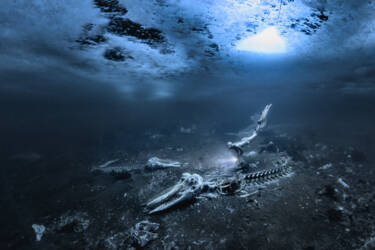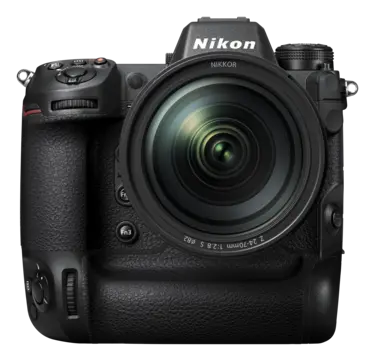How to become an underwater photographer

Having plunged to depths of 110m during his career, Alex Dawson is an expert underwater photographer. Here he shares how to get started
“I wanted to show my friends and family, and basically the world, what it’s like to be underwater,” says Alex Dawson, who has been capturing life beneath the surface since 1993. Starting out with a Nikon F90x, Alex is entirely self-taught, developing his skills through years of trial and error during the era of film. Initially focused on marine life, the Stockholm-based photographer transitioned to underwater wrecks and caves in 2007, and became a full-time freelance underwater photographer in 2019, where he’s earned global recognition and accolades for his evocative subaquatic seascapes, including being awarded 2024 Underwater Photographer of the Year.
Tip 1: Keep images true to life with ambient light
“For underwater photography start with a wide angle lens, such as a 24mm, 16mm or a circular fisheye,” says Alex, who typically teams his Nikon Z9 with a NIKKOR AF-S Fisheye 8-15mm f/3.5-4.5E ED (via a FTZ II Mount Adapter) inside his Nauticam Z9 housing with a 9-inch glass dome. “The key is to photograph making use of the natural light from above. For this, you’ll need to use slow shutter speeds, pretty wide-open aperture and a very high ISO.”
Whale Bones
“This image (above) was taken near Tasiilaq, Greenland. The little triangle is a hole in the ice, which is 1m thick. I was the first one in. It was pitch black, I couldn’t see anything, and then all of a sudden, as my eyes adjusted, I saw this whale bone. It was spectacular, very spooky, but also very fascinating. Here I asked swimmer Anna to swim along the whale bone slowly, shining her Bigblue dive light at 45° so that I could use a slower shutter speed without getting motion blur. It was 6m down and the water was 2°C – but that’s why the Z9 is one of the most powerful cameras: it has a huge battery pack. Very few cameras would last for hours in those conditions and would turn into ice cubes the moment you resurfaced! With the Z9, I can not only take stills, but also film 8K 50fps, RAW, for four hours on just one charge.”


Tip 2: Start simple and get close
“Start by photographing things that are close, like an anchor, so you really understand how everything works,” Alex advises. “Underwater, I use the camera very sparsely; all I need is a trigger, focus button, ISO, aperture and shutter. That’s where my needs stop.”
Hammerheads
“Hammerheads was taken 40m down in the Socorro Islands, Mexico. I was using a rebreather, which is a closed-circuit system where you breathe the same gas over and over. It’s great for times like this, because many animals, like hammerhead sharks, don't like the bubbles and get really skittish. But with this set-up I can get closer without disturbing them. There wasn’t much time, perhaps 15 seconds and then they were gone, so I was firing away and got two or three images that were very nice.”
Tip 3: Capture in RAW, play in post
“Get really good at post-production, because it’s super necessary for underwater photography, and I only capture in RAW,” says Alex. “You’ll need to know how RAW works, understand the benefits and how you can get the most out of it to get the most out of the image. What I do in post varies from image to image, but often it needs to be brightened quite a lot. White Balance is the first adjustment I do, then colour correction and contrast. If I can, I try to correct skin tones.”
Yucatán Peninsula Cavern
“This cavern (above) is 6,070m across. The rock at the bottom is about 30m deep, and where the sunbeams come in at the top is 2m. I found a little shelf where I could lie on my stomach and hold the camera very steady. It was really necessary because I was using quite a low angle and was wide open and down to 1/10 sec, just to let in as much light as possible, because I didn’t want the divers to be blurry.”


Tip 4: A time and a place for artificial lights
Diver’s spotlights can do more than help with signalling between divers, they can also be used to add interest to an underwater scene, such as in this picture of the sunken HMS Hythe. “The diver is holding a Bigblue dive light,” Alex explains. “It’s a primary light so it’s spotted, instead of white like the video lights. I rarely use off-camera lighting.”
HMS Hythe
“The bow of HMS Hythe in Gallipoli, Turkey, is really majestic. It’s the most intact part of the whole ship. It rests at 78m, so quite deep, but it only takes three or four minutes to get down there. We spent about 20 minutes photographing the wreck, and then it took about 100 minutes to get up to the surface (to eliminate decompression sickness). It’s not too dark because it’s the Mediterranean sea, but we needed a radar set with the underwater scooters as there was a very strong current, although the movement adds to the image because it almost looks like the ship is still sailing.”
Tip 5: Use AF-S focus
“I use AF-S focus mode, using the cross points in the centre and the sides,” says Alex. “It’s very accurate. Nowadays, I preset the camera on the surface, because I know from experience how I like to shoot, so that when I’m down there I can focus 100% on composition, directing models or adjusting the light. That’s where your focus needs to be.”
Military tanks
“The Underwater Military Museum in Aqaba, Jordan is 20m deep, full of abandoned helicopters, artillery cannons, tanks, medical vehicles and jeeps in a convoy on a sandbar. Originally, there wasn’t much marine life but over time it’s become a habitat. Initially I was photographing vehicles in the other direction but, just before I went up, I saw the diver looking at these tanks. It’s a cool picture from behind where he's observing them, and I had the sun in the back, so there’s nice light.”


Tip 6: Never miss a frame with burst mode
Whether you’re free diving, in sub-zero temperatures or capturing images during the golden hour, time is of the essence, which is why Alex swears by Nikon’s burst mode. “I don’t photograph at 20fps, that would be too much data,” he says. “My go-to is 5fps. I still get the images I need and I don’t miss the moment. But for a cold environment, where I know the diving time is a maximum of 15 minutes, I might set it to 10fps just to increase my chances of getting the perfect moment.”
Sunset with divers
“It might look like two images, but this singular shot (above) was taken at sunset in Ras Muhammad National Park on the Sinai Peninsula in Egypt. The sky was just so magical. I underexposed for the sky, and one of my friends was holding a 3,000-lumen light, just to give a bit of extra light on the divers who were right below the surface doing decompression – otherwise it would have been pitch black underneath.”
Alex Dawson’s kitbag
Cameras:
Underwater lenses:
Underwater housing:
Lights:
- Bigblue dive lights (handheld light for diver and 6 x 65,000 lumens off-camera lights)
Other equipment:
- Dry suits and thick undergarments for cold water dives
- Underwater scooters (used in some dives)
More in Inspiration
Featured products
Uncover NIKKOR lenses

Unlock greater creativity











